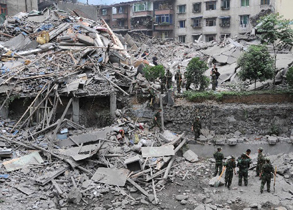


Foreword: EO reporter Zheng Chu arrived in Beichuan, one of the worst-hit areas by the 7.8-magnitude earthquake on May 12, a day after the disaster struck.
This reporter arrived in Beichuan town at 18:00 on May 13th.
By then, the People's Liberation Army (PLA) had already performed the first round of searches for survivors of the May 12 earthquake, and more rescue troops and supplies were on the way.
Renjiaping village was made the base for rescue teams, where the injured received treatment from the Red Cross by the roadside. Meanwhile, trucks of earthquake victims from nearby areas were being transported to Mianyang city for shelter.  Set in a valley surrounded by mountains, Beichuan is in the downstream of Wenchuan, and the White River is the umbilical cord that links the two with its dynamic flows. The geographical condition of Beichuan has made it susceptible to natural disasters during rainy seasons, especially landslide.
Set in a valley surrounded by mountains, Beichuan is in the downstream of Wenchuan, and the White River is the umbilical cord that links the two with its dynamic flows. The geographical condition of Beichuan has made it susceptible to natural disasters during rainy seasons, especially landslide.
In fact, landslides triggered by the May 12 earthquake had exacerbated the destruction in Beichuan. Take Maoba Middle School for instance, all traces of its existence – save a basketball hoop in the far end of a field – had "vanished" under fallen boulders from the hills. Of the 400 or more students and teachers there, merely one to two percent survived.
What's more disturbing was that the landslide had blocked the flows of the White River, creating an artificial lake in its upstream, near the Kuzhuba hydrolic dam. If the water pressure built up and threatened to burst the dam, the cost of life and property would be dreadful. The risks involved had added urgency and hazards to the rescue work that was racing against time.
Fire had broken out in several places in the town's old quarter, adding a black veil over the ruins. In the dusk, the occasional shouts from villagers and rescuers amidst the smoky ruins seemed to be echoed by moans from beneath the debris.
On the market street next to a bus station in the downtown, this reporter found a store still opened in an endangered building. The shop owner said everything was for free, and insisted to stuff a whole carton of cigarettes into the reporter's bag. Perhaps the goodwill was a way for the survivors to cope with the pain, to share warmth in bitter moment.
One of the latest groups to join the rescue effort was from a steel company, which sent a team of volunteers to remove debris. A dozen or so of them were seen using a wooden pillar to lift up a collapsed wall.
Stuck beneath a corner of the wall were three victims: a woman who died while hugging a man, himself holding a little girl in his arm. The girl, about three years old, was still alive. The adults had shielded her from falling debris but their dead bodies had also pinned down one of her legs, obstructing rescue.
As access road leading to the area was still blocked, heavy machinery had yet to be transported in, and rescue workers could only use inefficient hand tools like shovels and sticks to try lifting the weighty debris. Their labor proved to be in vain.
After a few futile hours, the group leader at last proposed a solution that no one had the heart to do so: cut apart the woman's body and removed her from the man to lift some weight off.
They knew the excess time spent on one survivor might compromise the lives of others still buried under debris, but the leader sighed: "I know others are waiting, but who has the heart to leave a crying child behind?"
Meanwhile, the frequency of aftershocks increased and the hills were threatening to cave in, warning signs for the rescuers to retreat to Renjiaping. They reluctantly bade farewell to the girl after giving her some water, a blanket and placed an umbrella by her side. They could only pray that she would still be alive the next day for further rescue effort.
But they didn't go back fruitless that night. They managed to carry an injured woman on a door-board-turned-stretcher fastened by ropes through two hours of slippery route back to Renjiaping.
That night, Fu Xingqiong and a group of Dongxi villagers arrived at the rescue center as fine rains weaved through the darkness. Fu would have stayed at home with the elders if not for hearing that her daughters' school, Beichuan Middle School, was also in ruins. On hearing the news, she and others had rushed down from the mountain.
The school was just 50 meters away from the rescue center. It was the biggest in Beichuan county, its six-storey building with over 20 classrooms were packed with students during the earthquake.
That night, dozens of soldiers were performing overnight searches on the collapsed building. In the afternoon alone, over 50 bodies had been recovered and laid on the ground for identification.
Fu, sitting in the rescue center, asked her husband to go out and check if their child was among the dead. But the latter hesitated to go out there as he feared all hope would be lost if he did.
As they talked over the matter, another tremor hit the center, yet nobody moved.
*Note: the little girl who was left pinning under the weight of two adults was finally rescued on May 14, at 09.40am.
Translated by Zuo Maohong and Ren Jie

